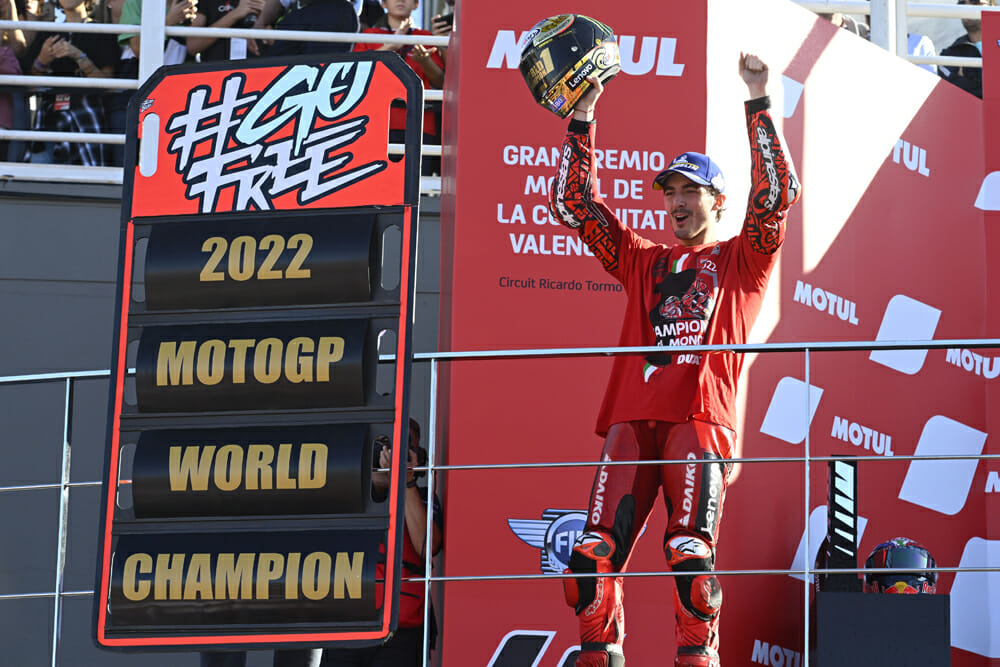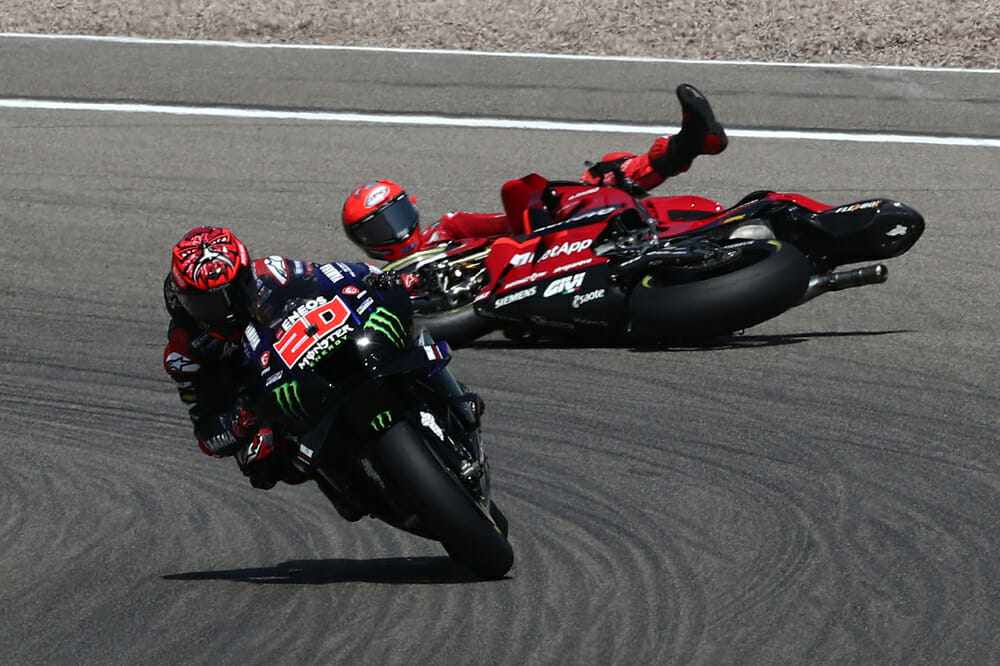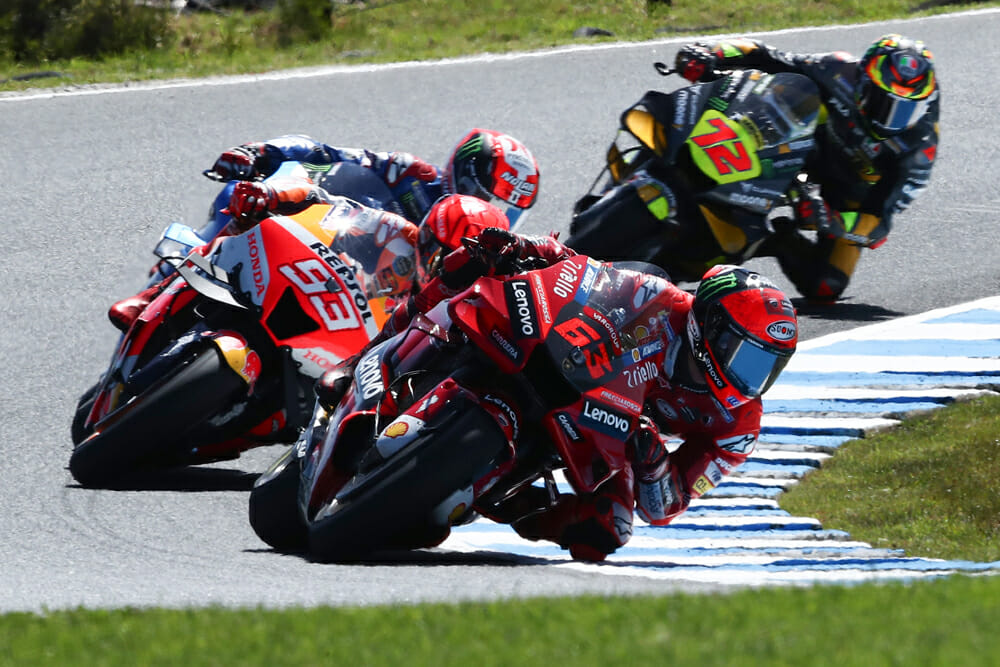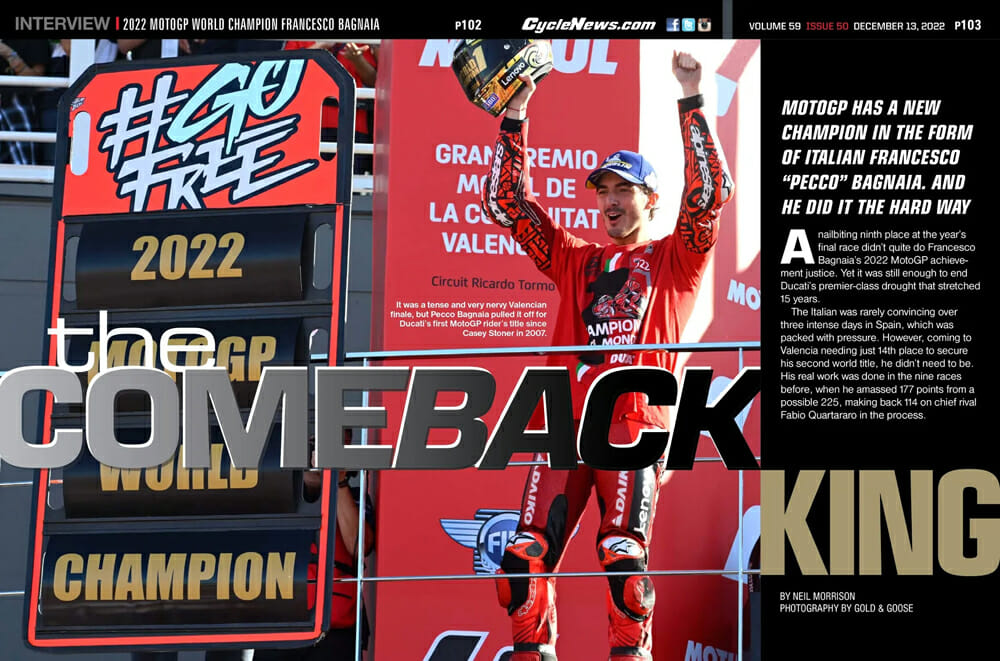Neil Morrison | December 28, 2022
MotoGP has a new champion in the form of Italian Francesco “Pecco” Bagnaia. And he did it the hard way.
 It was a tense and very nervy Valencian finale, but Pecco Bagnaia pulled it off for Ducati’s first MotoGP rider’s title since Casey Stoner in 2007.
It was a tense and very nervy Valencian finale, but Pecco Bagnaia pulled it off for Ducati’s first MotoGP rider’s title since Casey Stoner in 2007.
Photography by Gold & Goose
A nail-biting ninth place at the year’s final race didn’t quite do Francesco Bagnaia’s 2022 MotoGP achievement justice. Yet it was still enough to end Ducati’s premier-class drought that stretched 15 years.
The Italian was rarely convincing over three intense days in Spain, which was packed with pressure. However, coming to Valencia needing just 14th place to secure his second World title, he didn’t need to be. His real work was done in the nine races before, when he amassed 177 points from a possible 225, making back 114 on chief rival Fabio Quartararo in the process.
Yes, Bagnaia’s Ducati Desmosedici GP22 was the grid’s best bike. And an argument could be made that Quartararo’s refusal to give in all year long despite the severe shortcomings of his underpowered Yamaha YZR-M1 was worthy of greater admiration. Even Bagnaia admitted later his rival “still is the more complete rider.” But the cold, hard facts are no one won as many races (seven) as the 25-year-old in 2022. No one ascended the podium as often (10). And no other rider amassed as many front-row starts (11) or more pole positions than Bagnaia’s five.
 Bagnaia greets fiancée Domizia Castagnini after a hectic battle with Bastianini in Malaysia.
Bagnaia greets fiancée Domizia Castagnini after a hectic battle with Bastianini in Malaysia.
Perhaps most impressive was that his biggest winning margin of the season was six-tenths of a second.
“This year I was always with a lot of pressure from behind,” Bagnaia said. “Enea [Bastianini, his 2023 factory Ducati teammate] was fast behind me, trying to overtake and I was trying to manage the situation. It’s one where you can easily lose your concentration. But I think we worked well. At [Valentino’s] Ranch, we are always together, fighting like this, putting a lot of pressure on each other. So, this helps in these situations.”
Yes, he made mistakes [he’s the first premier-class champ in history with five DNFs to his name]. But aside from a brainless crash in Japan, he has stood up to the most high-pressure situations anyone could imagine. Then there is the small matter of the deficit he overcame. No rider in 74 years of premier-class competition has come back to win from a 91-point deficit, a fact that speaks to a deep reserve of self-belief.
 The moment it all changed. Bagnaia’s crash in Germany signaled the beginning of the greatest points comeback since the world championship was created in 1949.
The moment it all changed. Bagnaia’s crash in Germany signaled the beginning of the greatest points comeback since the world championship was created in 1949.
By doing so, Bagnaia smashed Wayne Rainey’s record for the biggest comeback when the American triumphed in 1992 despite being 65 points behind Mick Doohan. This is the standout point of his title and one that will ensure it is remembered in years to come.
“I just lost faith in the championship for like one hour after the race at the Sachsenring,” said the champion of 2022 after his race crash in Germany. “But from that moment, I knew there was still a chance. We tried to analyze everything at home: what to improve, why I was crashing, why I was committing so many mistakes. But from that moment, we did something incredible.”
 Fellow VR46 Academy graduate and close friend Franco Morbidelli shadows Bagnaia in the final laps of the Valencian finale.
Fellow VR46 Academy graduate and close friend Franco Morbidelli shadows Bagnaia in the final laps of the Valencian finale.
A Shaky Start
Yet none of this seemed possible in the year’s opening stage as Bagnaia cut a largely exasperated figure through the first five grands prix. His polite, patient demeanor was replaced by moody dealings with the media.
The reasons behind this less-than-perky Pecco were glaringly apparent: Ducati had ended 2021 in a tremendous position of strength, dominating the final race by locking out the front row and podium for the first time in history. That followed with a positive test at Jerez, where Bagnaia proclaimed, “The old bike was perfect already, and we are improving this perfect bike.”
But what arrived at the Sepang test in February was far from his—or any of the four other riders on the GP22—liking. The engine was too peaky and aggressive. It offered little of the front-end stability in braking for which its predecessor was famed. And it seemed that the incessant tinkering of Gigi Dall’Igna, Ducati Corse’s General Manager, had gone too far. Yes, the ride-height device, first introduced in 2019, that lowered the rear of the bike on corner exit was quickly adopted by all the grid’s other bikes. But the new device, which lowered the front of the bike and was eventually abandoned by the factory team, required a complete change in riding technique.
 The racing in 2022 was sometimes ferocious like the classic staged at Phillip Island in Australia.
The racing in 2022 was sometimes ferocious like the classic staged at Phillip Island in Australia.
And it didn’t end there: Bagnaia was so displeased with Ducati’s ’22 engine in testing that he requested a dramatic change before the first race—both he and teammate Jack Miller would go back to “a slightly hybrid version between the ’21 and ’22 engine,” according to Sporting Director Paolo Ciabatti. But still, it wasn’t done. Bagnaia and Ducati went to the first race chopping and changing parts and setup. The lead rider was not amused. It underlined a weakness to which many could relate. “He wants to come up with a base setup and then make very little changes to it,” admitted Ciabatti.
Still, it got worse. Bagnaia was all over the place on Saturday in Argentina, repeatedly throwing his hands up in the air before teammate Jack Miller put a caring arm around his shoulder. That was before a painful qualifying crash in Portugal put his participation in that GP in some doubt. Their issues were exacerbated by the state of the grid. Yamaha was running the same underpowered bike as the previous year, while Honda and KTM were miles off. Ducati was standing in front of an open goal. The speed of the GP21 in Bastianini’s hands was an added insult. Free of testing responsibilities aboard a fully sorted bike, the Italian swept to three wins in the first seven races, a galling sight for those grappling to find a base setting with new hardware.
 Enea Bastianini congratulates Bagnaia after their Malaysian boxing match. You can see Bagnaia wasn’t pleased by his 2023 teammate’s repeated attacks for the lead with so much on the line.
Enea Bastianini congratulates Bagnaia after their Malaysian boxing match. You can see Bagnaia wasn’t pleased by his 2023 teammate’s repeated attacks for the lead with so much on the line.
The Comeback
But by Jerez, Ducati engineers had found a base setting that returned Bagnaia’s confidence when braking robustly on the front end, where much of his work is done. But crashes at Le Mans when chasing Bastianini, and Barcelona, when taken out, negated those gains. Then came the season’s nadir at Sachsenring when another careless fall left him really up against it.
At this point, it wasn’t just the support of Ducati that came in. Members of the VR46 Academy rallied around Bagnaia and told him a few home truths. “In my situation, I love when some people around me say what they think about me,” Bagnaia said of that moment. “I’m a difficult guy because at the start I say, ‘No, it’s not like that.’ Then I try to change my mindset, to change myself, taking that advice on board.” Uccio Salucci, team manager for the Mooney VR46 squad and Valentino Rossi’s long-time right-hand man, agreed.
 The VR46 brotherhood—Bagnaia (right) with Uccio Salucci and Marco Bezzecchi.
The VR46 brotherhood—Bagnaia (right) with Uccio Salucci and Marco Bezzecchi.
“[After Germany] he said he was stupid but he understood why he crashed. When a rider understands why he crashes, it’s easier to recover, to restart. Pecco stayed calm and the guys in the Academy were together. The Academy grouped around him in that moment.”
“The most difficult moment was at the Sachsenring because I was very competitive,” Bagnaia explained. “Like in Le Mans, I was there with a possibility to win, but I crashed. In that moment, I recognized that my weak point was there, that I was a rider with a lot of ups and downs.”
The French and German GP crashes were of a similar kind—when settling in behind the bike ahead, thinking too much of the final laps.
“In those two moments, I had said, ‘I will be calmer, breathe and then come back.’ But right away I crashed,” he acknowledged at Assen. “Maybe with our bike, my feeling is that when you are not pushing on the tires maybe it’s easier to crash.”
From then on, the only focus was the immediate job at hand.
By then, it was clear the teething problems with Ducati’s GP22 were a thing of the past. Most in the factory felt a run of victories wasn’t beyond them.
“We never gave up in the very bad moments,” said Bagnaia’s Crew Chief, Cristian Gabarrini, the man who guided Casey Stoner to his two World titles. “It’s easy to be happy when everything is fine. But the trick is to be strong when everything goes wrong. Every person in this project never lost focus, which was to win this championship. Pecco felt that and this was some additional momentum for him.”
 Fabio Quartararo congratulates Bagnaia in Valencia pit lane moments after Bagnaia took the title.
Fabio Quartararo congratulates Bagnaia in Valencia pit lane moments after Bagnaia took the title.
The advice and support worked. Four races, which demonstrated his strongest attributes, namely tire management, and exceptional late-braking ability, followed. Quartararo, meanwhile, had lost all of that midseason assurance. He lost the ability to qualify on the front row, and misfortune stalked him at Aragon and Thailand. The wet encounter at the Chang International Circuit told Bagnaia the championship was his.
“Thailand was a very difficult race for me, I struggled a lot in the wet. But I tried everything to be on the podium and recovered a lot of points. In that moment, I recognized we could win it.”
Two races later, he had 23 points in hand, a reversal of 114 in just nine outings. “That gave me the margin to control the gap (going to Valencia).”
 Valentino Rossi gives up the spoils to the new Italian hero and the first graduate of the VR46 Academy to take the MotoGP title, Bagnaia.
Valentino Rossi gives up the spoils to the new Italian hero and the first graduate of the VR46 Academy to take the MotoGP title, Bagnaia.
The VR46 Academy’s First Champion
Bagnaia’s championship win wasn’t just a triumph for himself, Ducati and Italy—it also marked the first occasion a rider from Valentino Rossi’s fabled VR46 Academy claimed the sport’s highest honor.
Established in 2014, the school for the next generation of Italy’s talent grew out of Rossi’s desire to put Italy back on the racing map. Before then, the country’s prospects were falling short in the junior classes. Rossi was still attracting worldwide attention, but glancing at the nation’s Moto2 and Moto3 entries didn’t inspire wonder. Take 2013, for example. The country’s intermediate class hopes fell on experienced names Mattia Pasini and Simone Corsi. The best-placed Italian in Moto3 was 10th. And all the while, Spain was cleaning up across the board.
2022 produced a challenge for Bagnaia, Morbidelli, Luca Marini and Marco Bezzecchi—the Academy’s MotoGP representatives: Rossi’s retirement. Before, the 42-year-old was ever-present at racetracks to offer advice. But he only attended three GPs this year.
“Without Vale, we passed through tough moments,” said half-brother Marini. “When we were training, we had a key point, like an idol, to follow every day. Without him it’s been a bit more difficult.”
Bagnaia heaped praise on the Academy after his championship triumph. “It’s not just the influence of Valentino but all the guys, all the people are working for us at home,” he said. “At the start, it was a totally different academy. It was a big help for sure, but now we are very professional. We can say, ‘Today, I want to go to a track with the pocket bikes.’ And they organize everything to do it. We say, ‘We want to go to Portimao to have a test before the season.’ They organize it. They are giving all the possibility, all the passion to us, and this is incredible.
“At home, we work together. We push each other to improve ourselves. When I looked at Frankie in 2020, finishing second in the championship, it was like a reference to me. Was something to improve or something to beat. This helped me a lot to improve myself.”
 Bagnaia’s Crew Chief, Cristian Gabarrini, guided Casey Stoner to his two World titles and can now add a third with Bagnaia. “I don’t think his growth is at an end—he’s only halfway,” said Gabarrini.
Bagnaia’s Crew Chief, Cristian Gabarrini, guided Casey Stoner to his two World titles and can now add a third with Bagnaia. “I don’t think his growth is at an end—he’s only halfway,” said Gabarrini.
More To Come
There is no doubt Bagnaia’s mettle will be tested like never before 2023. Not only should Quartararo have faster equipment, but Marc Marquez should also be nearing his level if Honda can deliver. And everything Bastianini did in the second half of this season made it perfectly clear he will do everything within his power to unsettle his countryman, Bagnaia, from his position as factory number one.
But that fails to take Bagnaia’s own margin for improvement into account. He is only the second rider to have triumphed in both Moto2 and the MotoGP classes, behind Marquez. And just imagine what he can do from the start of next year if Ducati doesn’t try and reinvent the wheel over winter.
“I don’t think his growth is at an end—he’s only half way,” said Gabarrini. “He’s growing every race and showing us this by controlling the pressure, the other competitors, or making a super-explosive lap in qualifying. He doesn’t know where his limit is, which is good because we can look toward the future with a positive trend.”
And now that he has secured the biggest gong the sport has to offer, the man that wears the phrase “Go Free” on the back of his leathers finally has a heavy burden off his shoulders.
“I think you never stop improving, never stop growing, never stop learning,” Bagnaia said. “I have a lot of things to improve. I have a lot of things to learn. Also, the way to speak with the journalists sometimes could be better. But I think it’s normal. I’m only 25 years old. Also, as a man, I am growing. It’s part of the circle of the life. In this moment, I feel more free. I feel that the job is done.”CN

Click here for all the latest MotoGP news.